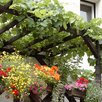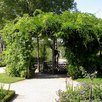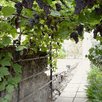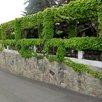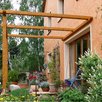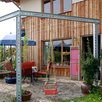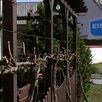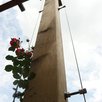Greening a Pergola
Pergolas are designed to accomodate climbing plants, to provide wonderful shade and a space to relax. Typically strong constructions with a solid frame made of wood or metal with transverse beams, between which cables can be stretched to make it easier for plants to climb. Stainless steel ropes are ideal for greening your self-made pergola; you'll find examples below. This applies to the roof, sides, and columns. Please also note the examples for arcades/archways and grapevines. In the next section of other building parts, we'll address green roofs (canopies) *without* frames.

Greening a Pergola Roof
In most cases, the roof area of a pergola is greened the same way a canopy would be. But only climbing plants that can easily grow 3m and higher are suitable. Grapevines are often an option. Learn more under pergola vines.
The following are also options: wisteria, Dutchman's pipe, Clematis montana, kiwi, ivy, evergreen honeysuckle, akebia, rose, trumpet vine and wild grape (fruitless grapevines). Systems that are designed with horizontal and longitudinal axes are ideal... in other words, systems that have grid forms with 30 - 50 cm meshes. Smaller meshes, like you'll have with nets or prefab rigid trellises, require more maintenance because more lignified tendrils and foliage have to be removed. In most cases, a pergola already has lines in one axial direction ~ strong parallel beams or rafters. Wire rope (3 mm) is pulled crosswise through these elements and fastened with clamping rings KL 00034. For this purpose, FassadenGrün presents the system 0060 in several versions. If you don't want to drill through the wooden rafters, the alternative would be to use eyelet screws (for example WH 07080) on the outer or inner side of the rafters and beams, along with staples and staple nails, and then the cables can be guided through them. This alternative is analogous to our easy kits.
Greening the Side Areas
To create privacy, a pergola's sides are often greened (as one would do for a carport); usually this is done with an ivy or a grapevine shaped into a vertical cordon, fan, horizontal cordon, or trained in the vineyard style. Various wire rope arrangements (d= 3 mm) are thus needed to support your desired shape. System 0010 (or individually designed systems similar to this system) are suitable for vertical ropes. With horizontal cable systems like 1060 or even 1040, the distance between the pergola's pillars is often too great to get adequate tension (that is, you may get sagging ropes). In such cases, we recommend an additional vertical strand (a "hanger") in the middle of each field between the two posts. This wire is fastened to one of the upper beams or purlins with an eyelet screw (WH 07080). The horizontal and vertical wires are attached to one another via cross clamps (SK 03012) at the intersecting points. Many combinations of horizontal and vertical wire ropes are possible. See examples in the photo gallery below.
Greening the Pergola Posts
Pergola supports are greened much like pillars and columns -- with annual climbing plants, clematis-hybrids, or even roses. Wire ropes (d = 3 mm) are tensioned vertically as with systems 1020 and 1030. Depending on the desired effect (one-sided or circumferential greening), you'll need 1 - 4 strands per post. If the pergola posts are particularly massive, you can even put two on each side, as with 4020.
FassadenGrün's light or easy kits are genearlly suficient, but with systems in our medium or heavy version, you can increase the space between the climbing plant and the pillar to give the plant a fuller, more abundant effect. Massive kits can also be used for representative and design reasons. The choice of construction style depends on the material/substrate (with pergolas, you are usually dealing with solid wood).

Greening of posts with a clematis hybrid on vertical cable

Examples of greened pergolas...
Many climbing plants are a good fit for pergolas. Click the photos to see full size. More grapevine examples under grapevine training on pergolas.






